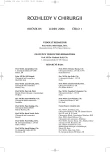Variation of Microvascular Blood Flow Augmentation – Supercharge in Esophageal and Pharyngeal Reconstruction
Authors:
M. Sekido 1; Y. Yamamoto 1; H. Minakawa 1; S. Sasaki 1; H. Furukawa 1; T. Sugihara 1; K. Nohira 2; K. Yajima 2; Y. Shintomi 2; S. Okushiba 3; H. Kato 3; A. Watanabe 4; M. Hosokawa 4
Authors‘ workplace:
Department of Plastic and Reconstructive Surgery, Hokkaido University Graduate School of Medicine, Sapporo, Japan, Chief Professor: Yuhei Yamamoto, MD, PhD
1; Soshundo Plastic Surgery, Sapporo, Japan, Director: Yoshihisa Shintomi
2; Department of Surgical Oncology, Hokkaido University Graduate School of Medicine, Sapporo, Japan, Chief Professor: Hiroyuki Kato, MD, PhD
3; Keiyukai Sapporo Hospital, Sapporo, Japan, Director: Masao Hosokawa, MD, PhD
4
Published in:
Rozhl. Chir., 2006, roč. 85, č. 1, s. 9-13.
Category:
Monothematic special - Original
Overview
Aim of the study:
A gastric tube is commonly used in thoracic esophageal reconstruction. When a gastric tube is not available, pedicled jejunum transfer and colonic interposition are alternative methods. Oral end of the reconstructed esophagus occasionally has poor blood flow and may result in partial necrosis of the oral segment We performed additional microvascular blood flow augmentation, the “supercharge” technique, to improve a blood flow circulation in the oral segment of the reconstructed esophagus.
Methods:
A series of 86 esophageal reconstructions with microvascular blood flow augmentation using the “supercharge” technique were performed. Reconstructive methods included a gastric tube in five patients, a gastric tube combined with a free jejunual graft in one, an elongated gastric tube in eight, a pedicled colonic interposition in 22, and a pedicled jejunum in 50. Recipient vessels were used in neck or chest region.
Results:
The color and blood flow of the transferred intestine appeared greatly improved after microvascular blood flow augmentation. Thrombosis was noticed in three patients during the surgery, and all thrombosies were salvaged by re-anastomosis. There were only three patients with partial graft necrosis of oral segment, two patients with anastomotic leakage, one anastomotic stricture.
Conclusions:
Augmentation of microvascular blood flow by this “supercharge” technique can be expected to reduce the risk of leakage and partial necrosis of the transferred intestine. This technique contributes to the successful reconstruction of esophageal defect.
Key words:
esophageal reconstruction – supercharge – microsurgery – blood flow augmentation
Labels
Surgery Orthopaedics Trauma surgeryArticle was published in
Perspectives in Surgery

2006 Issue 1
Most read in this issue
- Biliary Reflux in a Reflux Disorder of the Oesophagus
- The Glomus Caroticum Tumor – an Unusal Case
- Gas in the Portal and Mesentrial Venous Bed in a Vascular Ileus
- Safe Distance of the Inferior Resection Line in the Rectal Carcinoma Surgery
